
Queen Anne 1702-1714 English Costume History by Dion Clayton Calthrop
- THE MEN AND WOMEN
- A MAN OF THE TIME OF QUEEN ANNE - 1702-1714
- A RUNNING FOOTMAN
- A WOMAN OF THE TIME OF QUEEN ANNE -1702-1714

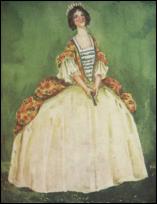 This costume history information consists of Pages 395-405 of the chapter on the first decade of the early C18th dress in the 12 YEAR REIGN era of Queen Anne 1702-1714 and taken from English Costume by Dion Clayton Calthrop.
This costume history information consists of Pages 395-405 of the chapter on the first decade of the early C18th dress in the 12 YEAR REIGN era of Queen Anne 1702-1714 and taken from English Costume by Dion Clayton Calthrop.
QUEEN ANNE
Reigned twelve years: 1702-1714. Born 1665. Married, 1683, Prince George of Denmark.THE MEN AND WOMEN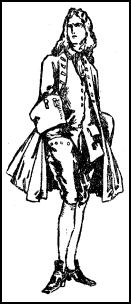
When I turn to the opening of the eighteenth century, and leave Dutch William and his Hollands and his pipe and his bulb-gardens behind, it seems to me that there is a great noise, a tumultuous chattering. We seem to burst upon a date of talkers, of coffee-houses, of snuff and scandal. All this was going on before, I say to myself - people were wearing powdered wigs, and were taking snuff, and were talking scandal, but it did not appeal so forcibly.
Sedan Chairs
We arrive at Sedan-chairs and hoops too big for them; we arrive at red-heeled shoes. Though both chairs and red heels belong to the previous reign, still, we arrive at them now - they are very much in the picture. We seem to see a profusion, a confused mass of bobbins and bone lace, mourning hatbands, silk garters, amber canes correctly conducted, country men in red coats, coxcombs, brass and looking-glass snuff-boxes. Gentlemen walk past our mental vision with seals curiously fancied and exquisitely well cut. Ladies are sighing at the toss of a wig or the tap on a snuff-box, falling sick for a pair of striped garters or a pair of fringed gloves. Gentlemen are sitting baldheaded in elegant dressing-gowns, while their wigs are being taken out of roulettes.Peruquier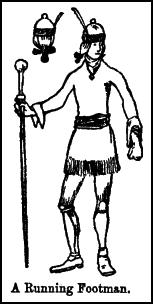
The peruquier removes the neat, warm clay tube, gives a last pat to the fine pipes of the hair, and then gently places the wig on the waiting gentlemen. If you can look through the walls of London houses you will next see regiments of gentlemen, their faces pressed into glass cones, while the peruquier tosses powder over their newly-put-on periwigs. The bow at the end of the long pigtail on the Ramillies wig is tied - that is over.
A Running Footman
Running footmen, looking rather like Indians from the outsides of tobacco shops, speed past. They are dressed in close tunics with a fringed edge, which flicks them just above the knee. Their legs are tied up in leather guards, their feet are strongly shod, their wigs are in small bobs. On their heads are little round caps, with a feather stuck in them. In one hand they carry a long stick about 5 feet high, in the top knob of which they carry some food or a message. A message to whom? The running footman knocks on a certain door, and delivers to the pretty maid a note for her ladyship from a handsome, well-shaped youth who frequents the coffee-houses about Charing Cross. There is no answer to the note: her ladyship is too disturbed with household affairs. Her Welsh maid has left her under suspicious circumstances, and has carried off some articles. The lady is even now writing to Mr. Bickerstaff of the Tatler to implore his aid. This is the list of the things she has missed - at least, as much of the list as my mind remembers as it travels back over the years:- A thick wadded Calico Wrapper.
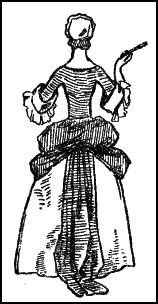
- A Musk-coloured Velvet Mantle lined with Squirrels' Skins.
- Eight night shifts, four pairs of stockings curiously darned.
- Six pairs of laced Shoes, new and old, with the heels of half 2 inches higher than their fellows.
- A quilted Petticoat of the largest size, and one of Canvas, with whalebone hoops.
- Three pairs of Stays boulstered below the left shoulder. Two pairs of Hips of the newest fashion.
- Six Roundabout Aprons, with Pockets, and four strip'd Muslin night rails very little frayed.
- A silver Cheese toaster with three tongues.
- A silver Posnet to butter eggs.
- A Bible bound in Shagreen, with guilt Leaves and Clasps, never opened but once.
- Two Leather Forehead Cloathes, three pair of oiled Dogskin Gloves.
- Two brand new Plumpers, three pair of fashionable Eyebrows.
- Adam and Eve in Bugle work, without Fig-leaves, upon Canvas, curiously wrought with her Ladyship's own hand.
- Bracelets of braided Hair, Pomander, and Seed Pearl.
- A large old Purple Velvet Purse, embroidered, and shutting with a spring, containing two Pictures in Miniature, the Features visible.
- A Silver gilt box for Cashu and Carraway Comfits to be taken at long sermons.
- A new Gold Repeating Watch made by a Frenchman.
- Together with a Collection of Receipts to make Pastes for the Hands, Pomatums, Lip Salves, White Pots, and Water of Talk.
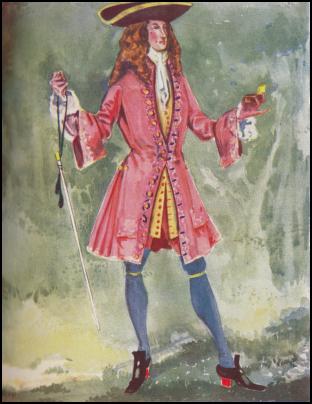
A MAN OF THE TIME OF QUEEN ANNE - 1702-1714
The coat has become still more full at the sides. The hat has a more generous brim. Red heels in fashion. This gentleman from the country will tell me all about it. I stop him and remark his clothes; by them I guess he has ridden from the country. He is wearing a wide-skirted coat of red with deep flap pockets; his coat has buttons from neck to hem, but only two or three - at the waist - are buttoned. One hand, with the deep cuff pushed back from the wrist to show his neat frilled shirt, is thrust into his unbuttoned breeches pocket, the two pockets being across the top of his breeches.Cravats
Round his neck is a black Steenkirk cravat (a black silk tie knotted and twisted or allowed to hang over loose). His hat is of black, and the wide brim is turned back from his forehead.
Long Aprons
Aprons are worn long, and have good pockets. Cuffs are deep, but are lowered to below the elbow. The bodice of the gown is cut high in the back and low in front, and is decked with a deep frill of lace or linen, which allows less bare neck to show than formerly.A WOMAN OF THE TIME OF QUEEN ANNE - 1702-1714 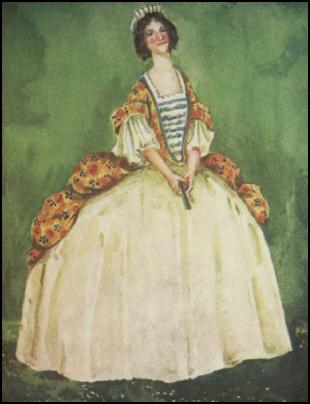
Notice that the fontage has become much lower, and the hoop of the skirt has become enormous. The hair is more naturally dressed.
New Hoops
A very observant gentleman! 'But you have seen the new hoop?' I ask him. Yes, he has seen it. As he rode into town he noticed that the old fashions gave way to new, that every mile brought the fontage lower and the hair more hidden, until short curls and a little cap of linen or lace entirely replaced the old high head-dress and the profusion of curls on the shoulders. The hoop, he noticed, became larger and larger as he neared the town, and the train grew shorter, and the patterns on the under-skirt grew larger with the hoop.The Ramillies White Wig
I leave my gentleman from the country and I stroll about the streets to regard the fashions. Here, I see, is a gentleman in one of the new Ramillies wigs - a wig of white hair drawn back from the forehead and puffed out full over the ears. At the back the wig is gathered into a long queue, the plaited or twisted tail of a wig, and is ornamented at the top and bottom of the queue with a black bow.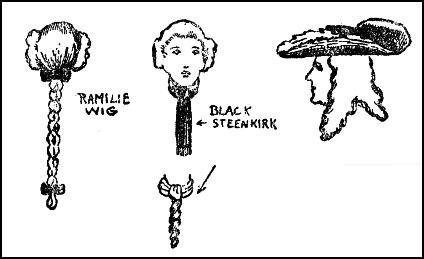 I notice that this gentleman is dressed in more easy fashion than some. His coat is not buttoned, the flaps of his waistcoat are not over big, his breeches are easy, his tie is loose. I know where this gentleman has stepped from; he has come straight out of a sampler of mine, by means of which piece of needlework I can get his story without book.
I notice that this gentleman is dressed in more easy fashion than some. His coat is not buttoned, the flaps of his waistcoat are not over big, his breeches are easy, his tie is loose. I know where this gentleman has stepped from; he has come straight out of a sampler of mine, by means of which piece of needlework I can get his story without book.
The Lady
There is another figure on the sampler - a lady in one of those wide hoops; she has a fan in her hand. I know her as well as the gentleman, and know that she can use her fan as becomes a prude or a coquette. I know she takes her chocolate in bed at nine in the morning, at eleven she drinks a dish of bohea, tries a new head at her twelve o'clock toilette, and at two cheapens fans at the Change.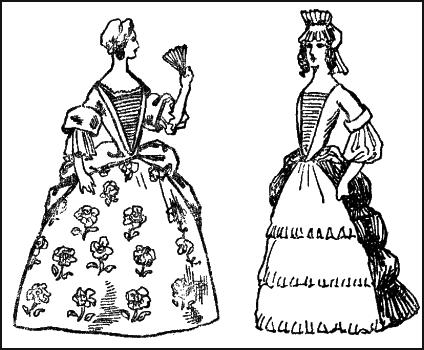
Anne - 1702-1714 - English Costume by Dion Clayton Calthrop Reigned twelve years: 1702-1714. Born 1665. Married, 1683, Prince George of Denmark.
- THE MEN AND WOMEN
- A MAN OF THE TIME OF QUEEN ANNE - 1702-1714
- A RUNNING FOOTMAN
- A WOMAN OF THE TIME OF QUEEN ANNE -1702-1714


NEXT GEORGE I 1714-1727
- Costume History Home
- Introduction to English Costume by Calthrop
- 1066-1216 Norman
- 1272-1485 Plantagenet
- 1485-1603 Tudor
- 1603-1714 Stuart
- 1603-1625 - James I - Jacobean Stuarts
- 1625-1649 - Charles I - Jacobean Stuarts
- 1649-1660 - Cromwell Years - Civil War - Roundheads
- 1660-1685 - Charles II - Restoration Of Monarchy
- 1685-1689 - James II
- 1689-1702 William and Mary
- 1702-1714 - Anne
- 1603-1830 Hanover
- Hollar Drawings Index
- Hollar English Costume Plates Page 1
- Hollar English Costume Plates Page 2
- Hollar English Costume Plates Page 3
- Hollar English Costume Plates Page 4
- Hollar English Costume Plates Page 5